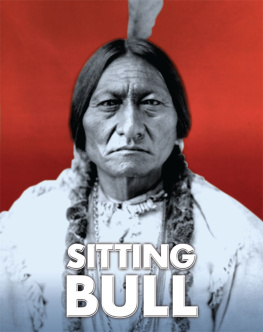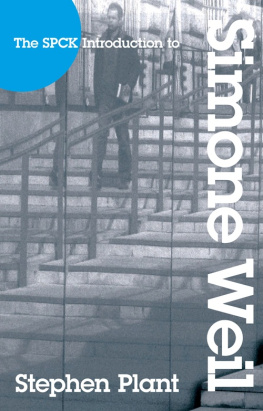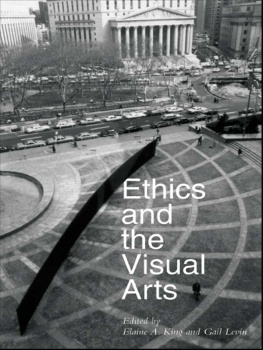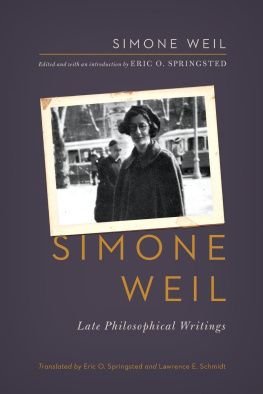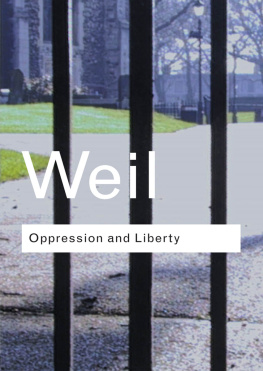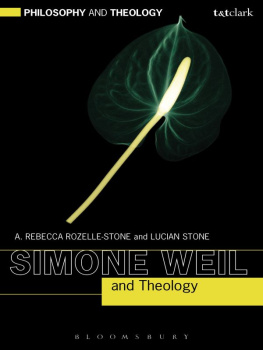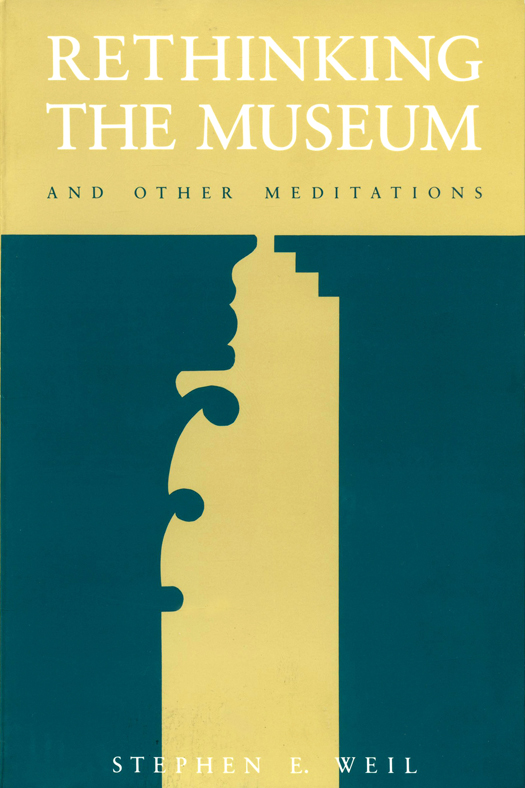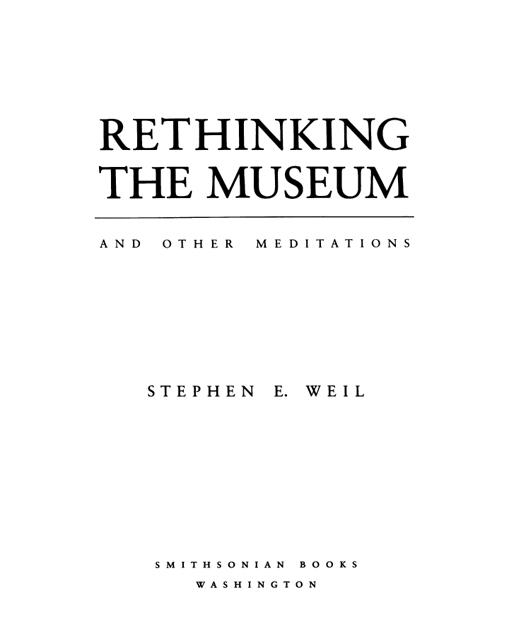1990 by the Smithsonian Institution
All rights reserved
Editor: Michelle Smith
Designer: Linda McKnight
Library of Congress Cataloging-in-Publication Data
Weil, Stephen E.
Rethinking the museum and other meditations / Stephen E. Weil.
p. cm.
Includes bibliographical references.
ISBN 0-87474-948-4 (alk. paper).
ISBN 0-87474-953-0 (pbk.: alk. paper)
eBook ISBN: 978-1-935623-66-3
1. MuseumsManagement. 2. Museum techniquesEvaluation. I. Title.
AM7.W393 1990
069.5dc20
89-21985
British Library Cataloguing-in-Publication Data is available
v3.1
For Wendy
CONTENTS

ACKNOWLEDGMENTS

W hile I have characterized the pieces in this book as meditations, their origins have been in anything but solitary contemplation. The starting point for most was in a continuing and often vigorous discourse with a wide range of colleagues both within and without the domain of museums.
As a source and testing ground for ideas, three committeesone planning, and two advisorywith which Ive had the good fortune to serve for a number of years have proven to be particularly important. Foremost in length of service is the Planning Committee for the American Law Institute-American Bar Association (ALI-ABA) annual Course of Study in the Legal Problems of Museum Administration. With a slowly shifting membership, that committee has been meeting since 1972. Through 1989, it had prepared and presented seventeen annual workshops of two-and-a-half days each at a variety of locations throughout the United States. The other members of the committee at this writingall of them attorneys who have represented museumsare Lauryn Guttenplan Grant, Philip C. Jessup, Jr., Marie C. Malaro, Peter G. Powers, Marsha S. Shaines, Alan D. Ullberg, Nicholas D. Ward, Linden H. Wise, and Beverly M. Wolff. Im grateful to them all.
Equally important has been the impact on my thinking of the Museum Management Institute (MMI) Advisory Committee, was put into its final written form by Earl F. Cheit and myself, the thinking it embodies evolved over a period of years as a group product of this committee (most recently: Robert B. Andrews, Malcolm Arth, Earl F. Cheit, Signe Hanson, Charles F. Hummel, Pamela L. Myers, Jane G. Rice, Harold Skramstad, Jr., and myself). Also working with us on the development of the MMI Curriculum Statement were Philip Nowlen, the director of MMI; Harold Williams and Lani Lattin Duke of the J. Paul Getty Foundation; and Myrna Smoot and Ricki Lederman of the American Federation of Arts. The learning curve has been a long one. For several of us, the experience of working together on the launch and first flights of MMI dates back to June 1977.
A more recent involvementbut equally a stimulus, particularly to my thinking about cultural institutions other than museumshas been my membership on the Advisory Board of the Research Center for Arts and Culture at Columbia University, an interdisciplinary project that combines elements from Columbias Business School, its graduate School of the Arts, and my own alma mater, the School of Law. Presided over by Joan Jeffri, director of Columbias Graduate Program in Arts Administration, the committees other members have most recently included Mary V. Ahearn, William Baumol, Paul DiMaggio, Ronald Feldman, Anthony Keller, Harold Klein, and Barbara Weisberger. The 1985 fragment A Meditation on Work at .
At the individual level, I am deeply indebted to a worldwide network of colleagues and friends. In Canada, Sheila Stevenson of the Nova Scotia Museum in Halifax gave the impetus to what eventually became The Proper Business of Museums: Ideas or Things? In Australia, it was Caroline Turner of the Queensland Art Gallery who was first responsible for my preparing In Pursuit of a Profession: The Status of Museum Work in America. In England, Peter Cannon-Brookes of The International Journal of Museum Management and Curatorship has been a constant encouragement.
United States colleagues and friends who have either helped to birth or groom some of the pieces in this book include Constance Lowenthal of the International Foundation for Art Research in New York; Elaine Heumann Gurian, once of the Childrens Museum in Boston, but now my co-worker at the Smithsonian; and Gail Anderson of the Center for Museum Studies at John F. Kennedy University in San Francisco. Throughout, Milton Sterndean of the University Extension at the University of California, Berkeleyhas been a patient sounding board for some ideas about museums that later proved to be both good and bad. John Henry Merryman of the Stanford Law School has done much the same with respect to some legal concepts of concern to museums. To my companion Joan Wendy Luke, I can only say the most profound thank you for all of her tact, personal understanding, and critical insight.
At the Smithsonian Institution Press, the smooth passage of this book from concept to concrete form was effected by a wonderful assembly of talented individuals. With the sympathetic support of the Presss director Felix Lowe, managing editor Ruth Spiegel and acquisitions editor Amy Pastan took immediate charge of the project. Working directly with me on the text was my prescient and second-sighted editor Michelle Smith, who often understood how I meant to say things before I even knew what it was I wanted to say. For the books design, I am deeply grateful to Linda McKnight.
Nothing in this volume would have been possible, however, except for a Smithsonian Institution tradition that permits and encourages its staff members to write, to teach andas a necessary concomitantalso to reflect. It has been my enormous good fortune to have been in such a situation for the years necessary to produce this and its predecessor volume. The two directors of the Hirshhorn Museum and Sculpture Garden under whom I have worked since 1974first Abram Lerner and then, following his retirement in 1984, James T. Demetrionhave been more than supportive of these efforts. As important has been the contribution of Carole Clore, my secretary and assistant for many years. Her patience with my constant rewriting (and sometimes wholesale recasting), her willingness to serve as a responsive and on occasion highly critical first reader, her extraordinary memory and her ingeniously resourceful abilities as a researcher are all reflected in the material that follows.
To all of them, and to the many other colleagues that space does not permit me to name, my heartfelt thanks. I can only hope that the product will prove worthy of their help. If not, the fault will have been mine. Their part was superb.
S.E.W.
PREFACE

W hile the pieces collected here were written over the relatively brief period of seven years, they vary enormously in style and even in their scholarly apparatus. Some tend toward the bare and laconic while others are generously footnoted. Some warmly address my museum colleagues as we while others maintain a cold and third-person impersonality. Some are humorous, a few are solemn. The genesis of this diversity lies in the diverse occasions for which they were first written as well as, in some instances at least, in the vagaries of their subsequent publication. I can only trust that their readers will find the resulting mix to a degree pungent and not too perplexing.





